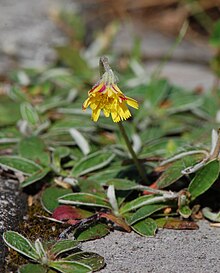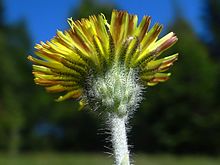Little hawkweed
| Little hawkweed | ||||||||||||
|---|---|---|---|---|---|---|---|---|---|---|---|---|

Lesser hawkweed ( Hieracium pilosella ) |
||||||||||||
| Systematics | ||||||||||||
|
||||||||||||
| Scientific name | ||||||||||||
| Hieracium pilosella | ||||||||||||
| L. |
The Small hawkweed ( Hieracium pilosella ), and mouse-ear hawkweed or haired hawkweed called, is a plant of the genus hawkweed ( Hieracium ) within the family of Compositae (Asteraceae).
description
The Small hawkweed grows as a perennial , herbaceous plant . Its narrow, egg-shaped, entire-margined leaves form a base rosette. They are covered with long hair on the top, gray-tomentose on the underside. Above-ground runners with daughter rosettes are formed up to 30 centimeters long .
The flowering period extends from May to October. The individually standing cup-shaped inflorescences have a diameter of 2 to 3 centimeters. The gray-felted flower stem is leafless and reaches heights of 5 to 30 centimeters. Which also graufilzigen blossom bracts are linear, 1 to 2 millimeters wide. The flower heads contain up to 64 light yellow ray florets . Outside single flowers often appear striped with red.
The fruit ripens from July to September. The individual fruits are unbeaked achenes that have a pappus in total .
The chromosome number is 2n = 18, 27, 36, 45, 54, 63, 81 or 90.
ecology
The hawkweed is a rosette plant. The vegetative reproduction takes place through runners with daughter rosettes.
In dry conditions, the leaves are rolled up with the bright, light-reflecting underside facing out to reduce warming.
From an ecological point of view, it is "cup flowers of the Leontodon type". The main pollinators are members of the genus of the shaggy bees ( Panurgus ), which comb out the pollen with their whole legs. The edge areas of the flowers reflect the UV light, which makes the flowers appear bicolored to pollinators in contrast to the otherwise similar forest hawkweed ( Hieracium murorum ). The flowers are open from 8:00 a.m. to 3:00 p.m. in the sun. Spontaneous self-pollination is successful, but the seeds usually emerge apomictically .
The achenes are tolerated by the wind or stick to the wet fur of animals. As an umbrella flyer, the fruits have a sink rate of 20 cm per second; thus flight distances of over 10 km are possible. The main spread is probably as watery.
Distribution and location requirements
The hawkweed is widespread throughout Europe, as well as in western Asia in the Caucasus and in western Siberia . It is a neophyte in New Zealand, the United States, and Canada .
The hawkweed is a light plant . It usually thrives on soils that are poor in nitrogen . They are often found on dry grass , in heaths , on paths and rain areas, in sparse forests and in crevices. It occurs particularly often in the initial stages of the Nardo-Callunetea societies.
In the Allgäu Alps , it rises on the Gottesacker plateau in Bavaria to an altitude of 1950 meters.
Systematics
The small hawkweed belongs to the genus of the hawkweed ( Hieracium ) and is placed in the subgenus of the mouse-eared hawkweed ( Hieracium subg. Pilosella ). Some authors call this species Pilosella officinarum Vaill. called. The name pilosella ("the one with hair", from Latin pilosus , hairy) refers to the hairy leaves of the plant.
use
The hawkweed is used as a wild garden plant for sunny walls and other dry locations. However, it does tend to spread widely.
The hawkweed can be used medicinally as a diuretic . An infusion is prepared for this.
proof
literature
- Dietmar Aichele, Marianne Golte-Bechtle: What is blooming there? 57th edition. Kosmos, Stuttgart 2005, ISBN 978-3-440-10212-1 , pp. 200 .
- Thomas Schauer, Claus Caspari: The FSVO plant guide for on the go . 2nd, revised edition. BLV, Munich 2008, ISBN 978-3-8354-0354-3 , p. 190 .
- Ruprecht Düll , Herfried Kutzelnigg : Pocket dictionary of plants in Germany and neighboring countries. The most common Central European species in portrait . 7th, corrected and enlarged edition. Quelle & Meyer, Wiebelsheim 2011, ISBN 978-3-494-01424-1 .
Individual evidence
- ^ A b c Thomas Schauer, Claus Caspari: The FSVO plant guide for on the go . 2nd, revised edition. BLV, Munich 2008, ISBN 978-3-8354-0354-3 , p. 190 .
- ↑ a b c Dietmar Aichele, Marianne Golte-Bechtle: What is blooming there? 57th edition. Kosmos, Stuttgart 2005, ISBN 978-3-440-10212-1 , pp. 200 .
- ↑ a b c d e f g h Ruprecht Düll , Herfried Kutzelnigg : Pocket dictionary of plants in Germany and neighboring countries. The most common Central European species in portrait . 7th, corrected and enlarged edition. Quelle & Meyer, Wiebelsheim 2011, ISBN 978-3-494-01424-1 .
- ↑ a b Erich Oberdorfer : Plant-sociological excursion flora for Germany and neighboring areas . With the collaboration of Angelika Schwabe and Theo Müller. 8th, heavily revised and expanded edition. Eugen Ulmer, Stuttgart (Hohenheim) 2001, ISBN 3-8001-3131-5 , pp. 999 .
- ↑ Pilosella officinarum in the Germplasm Resources Information Network (GRIN), USDA , ARS , National Genetic Resources Program. National Germplasm Resources Laboratory, Beltsville, Maryland. Retrieved August 11, 2015.
- ↑ Erhard Dörr, Wolfgang Lippert : Flora of the Allgäu and its surroundings. Volume 2, IHW, Eching 2004, ISBN 3-930167-61-1 , p. 697.
- ^ Werner Greuter : Compositae (pro parte majore). Pilosella officinarum Vaill. In: Werner Greuter & Eckhard von Raab-Straube (eds.): Compositae. at Euro + Med Plantbase - the information resource for Euro-Mediterranean plant diversity .
- ↑ Helmut Genaust: Etymological dictionary of botanical plant names. Birkhäuser, Basel / Stuttgart 1976, ISBN 3-7643-0755-2 , p. 292.
- ↑ Hawkweed - Small hawkweed - Pilosella officinarum Vaill. (Syn .: Hieracium pilosella L.) - Medicinal Plant Lexicon. Retrieved January 24, 2020 .
Web links
- John L. Strother: Hieracium. : Hieracium pilosella , p. 283, the same text online as the printed work , In: Flora of North America Editorial Committee (Ed.): Flora of North America North of Mexico. Volume 19: Magnoliophyta: Asteridae, part 6: Asteraceae, part 1 (Mutisieae – Anthemideae) , Oxford University Press, New York and Oxford, 2006, ISBN 0-19-530563-9 .
- Hieracium pilosella L., hawkweed. In: FloraWeb.de.
- Little hawkweed . In: BiolFlor, the database of biological-ecological characteristics of the flora of Germany.
- Profile and distribution map for Bavaria . In: Botanical Information Hub of Bavaria .
- Hieracium pilosella L. In: Info Flora , the national data and information center for Swiss flora . Retrieved July 9, 2016.
- Distribution in the northern hemisphere.
- Thomas Meyer: Hawkweed data sheet with identification key and photos at Flora-de: Flora von Deutschland (old name of the website: Flowers in Swabia )
- Data sheet on www.kaesekessel.de
- Images on www.kuleuven-kortrijk.be



